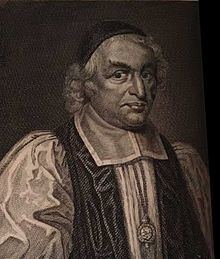Elected 1684 Name Peter Mews | Term ended 1706 (his death) Parents Thomas Winniffe Predecessor George Morley | |
 | ||
Other posts Archdeacon of Huntingdon (1649–1666)canon of Windsor (1662–1673)Archdeacon of Berkshire (1665–1673)President of St John's College, Oxford (5 August 1667–1673)Vice-Chancellor of Oxford University (1669–1673)Dean of Rochester (1670–1673)Bishop of Bath and Wells (19 December 1672 {elected}–November 1684) People also search for Thomas Winniffe, Eadwig, Eadred | ||
Peter Mews (25 March 1619 – 9 November 1706) was an English Royalist theologian and bishop.
Life
Mews was born at Caundle Purse in Dorset, and was educated at the Merchant Taylors' School, London, and at St John's College, Oxford, of which he was scholar and fellow.
When the Civil War broke out in 1642, Mews joined the Royalist army, and, having been made a captain, was taken prisoner at Naseby; but he was soon released and in 1648 sought refuge in Holland. He became friendly with King Charles I's secretary, Sir Edward Nicholas, and being skilful at disguising himself was very useful to the Royalists during the rule of Oliver Cromwell, undertaking two journeys to Scotland in 1653.
Before this Mews had been ordained. Taking the degree of DCL and regaining his fellowship at Oxford after the Restoration, he became Archdeacon of Huntingdon, vicar of St Mary's, Reading, and chaplain to the King; then, having obtained two other livings, he was made canon of Windsor, canon of St David's, and Archdeacon of Berkshire (1665–1672).
In 1667, when at Breda arranging peace between England and the Dutch Republic, he was chosen President of St John's College, Oxford, in succession to his father-in-law, Richard Baylie, afterwards becoming Vice-Chancellor of the University of Oxford and dean of Rochester. Appointed Bishop of Bath and Wells in 1672, Mews resigned his presidency in 1673, and in 1684 he was elected Bishop of Winchester, a position which this "old, honest cavalier," as Thomas Hearne calls him, filled until his death. The bishop is buried in Winchester Cathedral.
Mews lent his carriage horses to pull the cannon at a critical moment during the battle of Sedgemoor, where he was wounded whilst accompanying the royal army. He was, however, in sympathy with the Seven Bishops, and was only prevented by illness from attending their meeting; and as visitor of Magdalen College, Oxford, he supported the fellows in their resistance to James II, admitted their nominee, John Hough, to the presidency, and restored the ejected fellows in October 1688.
He took the oaths to William III and Mary II in 1689. In the absence of Henry Compton, Bishop of London, Mews took the chief part at the consecration of John Tillotson as Archbishop of Canterbury in 1691.
A superb portrait is displayed in the Great Hall of the 15th century manor house, Athelhampton Hall, known as Athelhampton House, just a few miles outside Dorchester in Dorset.
